Papers by Andreas Heinold
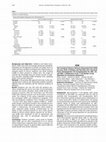
Background and Objectives: Umbilical cord blood transplants (UCBT) have been increasingly perform... more Background and Objectives: Umbilical cord blood transplants (UCBT) have been increasingly performed worldwide, prompting the development of private and public banks to collect and store umbilical cord blood units. Pediatricians are uniquely poised to discuss umbilical cord blood banking (UCBB) in either prenatal or sibling visits. We sought to evaluate the knowledge base and current practice of pediatric providers regarding UCBB, including views regarding public versus private donation. Methods: A 26-question IRB approved electronic survey was administered to general and subspecialty pediatric providers affiliated with our institution and the American Academy of Pediatrics. Results: Response rate was 20% with 473 pediatric providers completing the survey. Less than 11% of participants received any formal education about UCBB during their training or practice. Only 22% of providers ever discussed UCBB with expectant parents and conversations occurred rarely. The majority of this group responded incorrectly that autologous UCBTs were indicated in malignant (73%) and non-malignant conditions (61%). Providers practicing >10 years were more likely to address UCBB (p<¼0.001) while younger and female providers were significantly less likely to discuss UCBB within the general pediatric group (Table 1). Furthermore, 41% of providers either always or often supported public banking, predominately for the ability to help unrelated patients in need, while parents tended to discuss private options. Reasons for not discussing UCBB were attributed to lack of opportunity and knowledge and >90% of participants requested more education. Conclusions: Pediatric providers rarely speak to families about UCBB, and are often misinformed as to its clinical utility. Pediatricians, especially those newer in practice, are an underutilized resource to guide families about UCBB and would benefit from further education.

Transfusionsmedizin, Nov 1, 2022
ZusammenfassungMit den hochsensitiven Methoden zur Chimärismusanalyse kann ein Rezidiv bedeutend ... more ZusammenfassungMit den hochsensitiven Methoden zur Chimärismusanalyse kann ein Rezidiv bedeutend früher prognostiziert werden. Für die Prognose ist hierbei vor allem die Dynamik des Anstiegs im Eigenanteil entscheidend, dies gilt auch schon für sehr niedrige Werte (&lt; 0,1%). KM-Proben können über ihren variablen Eigenanteil durch Stromazellen die Erkennung einer Dynamik im niedrigen Prozentbereich (&lt; 1%) verschleiern und somit das Erkennen eines Rezidives erschweren. Die frühe Erkennung einer Dynamik in den sehr niedrigen Prozentbereichen erlaubt bei der Anwendung der sensitiven Methoden eine Reduktion der Anzahl der KM-Proben, was den Patienten weniger belastet. Durch zellfreie DNA und andere Faktoren kann ein „Grundrauschen“ bei sehr niedrigen Eigenanteilen auftreten, der diagnostische Wert von Eigenanteilen von 0,02% und kleiner ist daher fraglich.
Transplantation, Jul 1, 2014
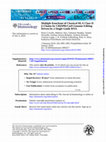
Journal of Immunology, Mar 15, 2019
Comprehensive knockout of HLA class II (HLA-II) b-chain genes is complicated by their high polymo... more Comprehensive knockout of HLA class II (HLA-II) b-chain genes is complicated by their high polymorphism. In this study, we developed CRISPR/Cas9 genome editing to simultaneously target HLA-DRB,-DQB1, and-DPB1 through a single guide RNA recognizing a conserved region in exon 2. Abrogation of HLA-II surface expression was achieved in five different HLA-typed, human EBV-transformed B lymphoblastoid cell lines (BLCLs). Next-generation sequencing-based detection confirmed specific genomic insertion/deletion mutations with 99.5% penetrance in sorted cells for all three loci. No alterations were observed in HLA-I genes, the HLA-II peptide editor HLA-DMB, or its antagonist HLA-DOB, showing high on-target specificity. Transfection of full-length HLA-DPB1 mRNA into knockout BLCLs fully restored HLA-DP surface expression and recognition by alloreactive human CD4 T cells. The possibility to generate single HLA-II-expressing BLCLs by one-shot genome editing opens unprecedented opportunities for mechanistically dissecting the interaction of individual HLA variants with the immune system.

Biology of Blood and Marrow Transplantation, Oct 1, 2017
Although quantitative PCR (qPCR) has been explored for chimerism monitoring after allogeneic stem... more Although quantitative PCR (qPCR) has been explored for chimerism monitoring after allogeneic stem cell transplantation (SCT), evidence regarding its clinical utility compared with standard short tandem repeat (STR) is still limited. We retrospectively studied commercial qPCR and STR chimerism with respective positivity thresholds of .1% and 1% in 359 peripheral blood (PB) and 95 bone marrow (BM) samples from 30 adult patients after first HLA-matched SCT for myeloid malignancies or acute lymphatic leukemia. Concordance between the 2 methods was 79.5%, with all discordant samples positive in qPCR but negative in STR. Of the latter, sporadic qPCR positivity without clinical correlates was seen mostly in BM samples early post-transplant. In 7 of 21 patients with available follow-up samples in the first months after transplantation, qPCR but not STR revealed low levels (<1%) of sustained host chimerism in PB, reflecting delayed engraftment or persistent mixed chimerism (PMC). These conditions were associated with donor-recipient cytomegalovirus (CMV) serostatus and early CMV reactivation but not with immunosuppressive regimens or clinical outcome. qPCR predicted all 8/8 relapses with samples in the 6 months before onset by sustained positivity in both PB and BM compared with 1/8 relapses predicted by STR mainly in BM. The response kinetics to donor lymphocyte infusions for the treatment of PMC or relapse was shown by qPCR but not STR to be protracted over several months in 3 patients. Our results demonstrate the superior clinical utility of qPCR compared with STR for monitoring subtle changes of host chimerism associated with different clinical conditions, making a case for its use in the clinical follow-up of transplant patients.
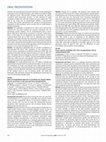
Journal of Hepatology, 2018
However, the quantification of steatosis by frozen-section histological evaluation is not a relia... more However, the quantification of steatosis by frozen-section histological evaluation is not a reliable technique, and is often unavailable at night for logistical issues. Non-invasive imaging techniques are poorly correlated with permanent sections, so that decision for graft acceptance finally rests with the surgeon, by gross appearance. The goal of our study was to prospectively validate a non-invasive (=contact-free) pocket spectrometer (PS) giving an extemporaneous estimation of macrosteatosis and to ensure that we could obtain a reliable estimation. Method: We evaluated a commercial PS (SCIO) never assessed for medical use. The gold standard for steatosis evaluation was the permanent section analysis. The PS communicated with a smartphone (Bluetooth connection) connected to internet (online database). A first stage (S1) of calibration was performed on 35 livers (macrosteatosis from 0% to 60%) and an algorithm was created, allowing a correlation between the estimation and the known values of graft steatosis. Then a second stage (S2) was carried out on 60 grafts (new cohort) during the procurement or after revascularization in the recipient to test the accuracy of the algorithm. The PS was placed at a distance <1.5 cm from the perfused liver (37°C). Results: The algorithm established after S1 reached a coefficient of determination R2 = 0.811. The validation of this algorithm (S2) showed a Lin's concordance correlation coefficient of 0.89. After the creation of clinically relevant ranges of steatosis (0-20%, 21-40%, 41-60%), the Kappa score evaluating the inter-tests variability (pathologists vs PS) was of 0.77 (p < 0.0001). The liver graft weight, the donor body mass index and the scannographic liver-to-spleen attenuation ratio did not predict the macrosteatosis (r < 0.5). Conclusion: Our study demonstrates that a PS allows a reliable and reproducible assessment of liver graft macrosteatosis. Its low cost and the immediacy of results may provide great value-added decision support, particularly when procurements are performed by unknown surgeons, to get an objective evaluation. This tool may avoid the travel of the surgical team in case of steatotic grafts, and avoid the prolonged cold ischaemia required by pathological examination in case of (potentially) marginal graft.
Viszeralmedizin 2021 Gemeinsame Jahrestagung Deutsche Gesellschaft für Gastroenterologie, Verdauungs- und Stoffwechselkrankheiten (DGVS), Sektion Endoskopie der DGVS, Deutsche Gesellschaft für Allgemein und Viszeralchirurgie (DGAV), 2021
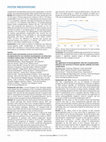
Journal of Hepatology, 2020
complications included biliary and vascular complications. A survival analysis was performed by K... more complications included biliary and vascular complications. A survival analysis was performed by Kaplan Mayer method with log rank test. Results: We included 43 SLKT recipients (56% male, median age of 58 (53-63) years). The liver disease was cirrhosis in 74% (n = 32) with a median MELD-score of 21 (20-22), and polycystic liver disease in 26% (n = 11) of patients. Unknown end-stage renal disease was observed in 12 36.2% (n = 12) of patients, with 54,8% (n = 23) of them requiring dialysis before transplantation. Median TPA was 1138 (926-1510) mm 2 , and sarcopenia was observed in 72% patients (n = 31). No difference was observed in 6 and 12 months patients or grafts survival censored for death in sarcopenia-group vs. non-sarcopenia-group (overall p = 0.76; liver graft p = 0.8; kidney graft p = 0.83, respectively). Six months post-operative complications free survival was not significantly different in the sarcopenia vs. non-sarcopenia-group respectively, 50% (95%CI: 0.284-0.880) vs. 53%, (95%CI: 0.3791-0.745), (p = 0.61). No difference in infection free survival was observed between two groups at 6 months: 52% (95%CI: 0.213-0.787) vs. 65% (95%CI: 0.4643-0.536), (p = 0.088). Conclusions: In this cohort of patients, no difference was observed among patients, grafts, complications or infection-free survival among SLKT sarcopenic or none patients. Future studies including more patients are needed to confirm and clarify these results. THU225 Recent trends and intention-to-treat survival of liver transplantation for non-alcoholic steatohepatitis: an Italian liver transplant registry study.
Zeitschrift für Gastroenterologie, 2018
74. Jahrestagung der Deutschen Gesellschaft für Gastroenterologie, Verdauungs- und Stoffwechselkrankheiten mit Sektion Endoskopie – 13. Herbsttagung der Deutschen Gesellschaft für Allgemein- und Viszeralchirurgie gemeinsam mit den Arbeitsgemeinschaften der DGAV, 2019
Gastroenterology, 2019
BACKGROUND & AIMS: Hepatitis D virus (HDV) superinfection in patients with hepatitis B virus (HBV... more BACKGROUND & AIMS: Hepatitis D virus (HDV) superinfection in patients with hepatitis B virus (HBV) is associated with rapid progression to liver cirrhosis and hepatocellular carcinoma. Treatment options are limited, and no vaccine is available. Although HDV-specific CD8 þ T cells are thought to control the virus, little is known about which HDV epitopes are targeted by virus-specific CD8 þ T cells or why these cells ultimately fail to control the infection. We aimed to define how HDV escapes the CD8 þ T-cell-mediated response. METHODS: We collected plasma and DNA samples from 104 patients with chronic HDV
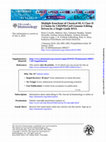
The Journal of Immunology, 2019
Comprehensive knockout of HLA class II (HLA-II) β-chain genes is complicated by their high polymo... more Comprehensive knockout of HLA class II (HLA-II) β-chain genes is complicated by their high polymorphism. In this study, we developed CRISPR/Cas9 genome editing to simultaneously target HLA-DRB, -DQB1, and -DPB1 through a single guide RNA recognizing a conserved region in exon 2. Abrogation of HLA-II surface expression was achieved in five different HLA-typed, human EBV-transformed B lymphoblastoid cell lines (BLCLs). Next-generation sequencing–based detection confirmed specific genomic insertion/deletion mutations with 99.5% penetrance in sorted cells for all three loci. No alterations were observed in HLA-I genes, the HLA-II peptide editor HLA-DMB, or its antagonist HLA-DOB, showing high on-target specificity. Transfection of full-length HLA-DPB1 mRNA into knockout BLCLs fully restored HLA-DP surface expression and recognition by alloreactive human CD4 T cells. The possibility to generate single HLA-II–expressing BLCLs by one-shot genome editing opens unprecedented opportunities fo...
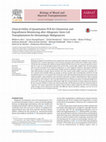
Biology of blood and marrow transplantation : journal of the American Society for Blood and Marrow Transplantation, Jan 8, 2017
Although quantitative PCR (qPCR) has been explored for chimerism monitoring after allogeneic stem... more Although quantitative PCR (qPCR) has been explored for chimerism monitoring after allogeneic stem cell transplantation (SCT), evidence regarding its clinical utility compared to standard short tandem repeat (STR) is still limited. We retrospectively studied commercial qPCR and STR chimerism with respective positivity thresholds of 0.1% and 1%, in 359 peripheral blood (PB) and 95 bone marrow (BM) samples from 30 adult patients after first HLA-matched SCT for myeloid malignancies or acute lymphatic leukemia. Concordance between the two methods was 79.5%, with all discordant samples positive in qPCR but negative in STR. Of the latter, sporadic qPCR positivity without clinical correlates was seen mostly in BM samples early post-transplant. In 7/21 patients with available follow-up samples in the first months after transplantation, qPCR but not STR revealed low levels (<1%) of sustained host chimerism in PB, reflecting delayed engraftment or persistent mixed chimerism (PMC). These con...
Journal of Hepatology, 2016
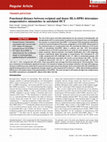
Blood, Jul 9, 2016
The role of HLA amino acid (AA) polymorphism for the outcome of hematopoietic cell transplantatio... more The role of HLA amino acid (AA) polymorphism for the outcome of hematopoietic cell transplantation (HCT) is controversial, in particular for HLA class II. Here we investigated this question in non-permissive HLA-DPB1 T-cell epitope (TCE) mismatches reflected by numerical functional distance (FD) scores, assignable to all HLA-DPB1 alleles based on the combined impact of twelve polymorphic AA. We calculated the difference in FD scores (ΔFD) of mismatched HLA-DPB1 alleles in patients and their 10/10 HLA-matched unrelated donors of 379 HCT performed at our center for acute leukemia or myelodysplastic syndrome. Receiver-operator-curve based stratification into two ΔFD subgroups showed a significantly higher percentage of non-permissive TCE mismatches for ΔFD >2.665, compared to ΔFD ≤2.665 (88% vs 25%, P <.0001). In multivariate analysis, ΔFD >2.665 was significantly associated with overall survival (hazard ratio [HR] = 1.40, 95% confidence interval [CI] = 1.05-1.87, P <.021) ...
The New England journal of medicine, Jan 28, 2014
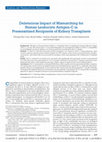
Transplantation, 2011
Background. Allocation of deceased donor kidneys is commonly based on matching for human leukocyt... more Background. Allocation of deceased donor kidneys is commonly based on matching for human leukocyte antigen (HLA)-A,-B, and-DR, whereas HLA-C is currently disregarded. We investigated the influence of HLA-C compatibility on renal allograft survival. In addition, we tested an approach of matching for HLA-C epitopes. Methods. A cohort of 2260 deceased donor kidney transplants were typed for HLA-C using polymerase chain reaction-sequence specific primer method. Samples for DNA typing, serum results on presensitization (lymphocytotoxicity), and clinical data were provided by transplant centers participating in the Collaborative Transplant Study. Results. HLA-C mismatch was found to be associated with significantly decreased graft survival in presensitized (PϽ0.001) but not in non-presensitized (Pϭ0.75) recipients. Mismatch of certain HLA-C epitopes seemed to be more influential than others, with mismatches showing a negative impact on graft survival in presensitized patients. Conclusions. HLA-C mismatch has a substantial deleterious effect on graft survival in presensitized kidney recipients. Our study points out the need for investigations directed at identifying donor-specific HLA-C antibodies and evaluating their relevance in transplantation. In view of the fact that current assays for determining HLA-C specific antibodies are hampered by additional detection of clinically irrelevant antibodies, matching for HLA-C may provide a reasonable approach to improve transplant outcomes in presensitized kidney transplant recipients.
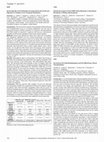
Transplantation, 2013
Introduction: The role of donor-specific HLA antibodies (DSA) following liver transplantation (LT... more Introduction: The role of donor-specific HLA antibodies (DSA) following liver transplantation (LTx) is not clearly established. Our aim was to assess the presence of DSA in pediatric LTx recipients. We hypothesized that DSA would be detected in patients with de-novo autoimmune hepatitis (d-AIH) and/or episodes of late acute cellular rejection. Methods: Serum was collected at routine clinic visits from 44 pediatric LTx recipients classified into four clinical phenotypes: non-tolerant (NON-TOL) with biopsy-proven d-AIH (n=13) and/or late acute cellular rejection (n=5); stable (STA) with normal liver function on maintenance tacrolimus (n=19); tolerant (TOL) with normal liver function off chronic immunosuppression ≥2 years (n=7). Samples were blinded and antibody detection was performed using Luminex single antigen class I and II beads. For 33 patients with known donor HLA typing, donor-recipient mismatched HLAs were compared, and positive DSA were defined as a normalized value >1000 mean fluorescence intensity (MFI). Statistical analyses were performed using fisher's exact tests, Kruskal-wallis tests, t-tests, and logistic regression. Results are expressed as percentages or mean ± SD. Results: Demographic data is summarized in the Table. Also shown in the Table, HLA antibodies were detected in the majority of patients. DSA were most common in the d-AIH group. Two STA patients had class I DSA. The remaining DSA were directed at class II antigens (44% DR and 56% DQ), with a mean of 1.8 DSA per patient. Mean DSA MFI was similar across groups (15453 NON-TOL, 9305 STA, 15538 TOL, p=0.33). Younger age at LTx and male sex showed a trend toward decreased likelihood of DSA. Primary diagnosis, number of prior transplants, and history of early acute cellular rejection were not associated with presence of DSA. For NON-TOL patients with known donor HLA typing, DSA were detected in 91% of those with d-AIH compared to only 25% of those without d-AIH (p=0.03). HLA antibodies were seen in all 4 patients with chronic rejection, however DSA could only be confirmed in 2 due to lack of donor HLA typing. There was a trend towards higher ALT and GGT in NON-TOL patients. Conclusion: DSA are common after pediatric LTx and are detected more frequently in NON-TOL compared to STA and TOL patients. Nearly all patients with d-AIH had DSA, suggesting d-AIH may be a form of antibody-mediated rejection. Although there is a trend towards DSA being associated with a history of late acute cellular rejection and/or chronic rejection, DSA do not always translate to allograft dysfunction. Further investigation is underway to analyze DSA in larger numbers of patients and to determine their association with additional clinical outcomes. NON-TOL with d-AIH (n=13)
Tissue Antigens, 2013
Mannose-binding lectin (MBL) is a major component of the lectin pathway of complement activation.... more Mannose-binding lectin (MBL) is a major component of the lectin pathway of complement activation. High and low MBL levels have been associated with susceptibility and severity of a variety of infectious and autoimmune diseases. Several single-nucleotide polymorphisms (SNPs) in the promoter region and exon 1 of the MBL2 gene are responsible for variations in serum MBL levels. We developed a sequence-based typing method for allele-specific MBL2 genotyping and measured serum MBL protein levels in 24 German blood donors. We identified the common MBL2 haplotypes including five promoter polymorphisms in linkage with the Q allele and correlated serum MBL levels with the respective genotypes. The genotyping method presented here could provide a basis for confirmatory studies in larger cohorts.








Uploads
Papers by Andreas Heinold